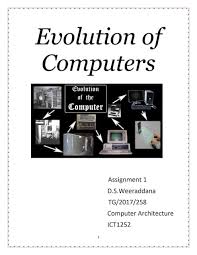
The Evolution of Computers: A Brief Overview
Computers have come a long way since their inception, evolving from room-sized machines with limited capabilities to the sleek and powerful devices we use today. Let’s take a look at the key milestones in the evolution of computers:
Mechanical Computers
The earliest computers were mechanical devices that used gears, levers, and switches to perform calculations. One notable example is the Difference Engine designed by Charles Babbage in the 19th century.
Vacuum Tube Computers
In the mid-20th century, computers began using vacuum tubes to perform calculations. These machines were large, expensive, and prone to overheating, but they represented a significant advancement in computing technology.
Transistor Computers
In the 1950s and 1960s, computers started using transistors instead of vacuum tubes. Transistors were smaller, more reliable, and more energy-efficient, leading to the development of faster and more compact computers.
Integrated Circuit Computers
In the late 1960s, integrated circuits revolutionized computer design by combining multiple transistors on a single chip. This innovation paved the way for smaller and more powerful computers that could be mass-produced at a lower cost.
Personal Computers
In the 1970s and 1980s, personal computers became increasingly popular with the introduction of machines like the Apple II and IBM PC. These affordable and user-friendly devices brought computing power into homes and offices around the world.
Mobile Computing
In recent decades, advancements in mobile technology have led to the widespread adoption of smartphones and tablets as portable computing devices. These devices offer unprecedented connectivity and computing power on-the-go.
From mechanical calculators to pocket-sized supercomputers, the evolution of computers has been marked by innovation, creativity, and relentless progress. As we look to the future, it’s exciting to imagine what new advancements will shape the next chapter in computer history.
Frequently Asked Questions: Key Milestones and Developments in the Evolution of Computers
- What are the key milestones in the evolution of computers?
- How did mechanical computers differ from vacuum tube computers?
- What role did transistors play in advancing computer technology?
- When did personal computers become popular, and what impact did they have?
- How has mobile computing contributed to the evolution of computers?
What are the key milestones in the evolution of computers?
The evolution of computers has been marked by several key milestones that have shaped the development of computing technology. From the invention of mechanical calculators in the 19th century to the introduction of integrated circuits in the late 1960s, each milestone represents a significant advancement in computing capabilities. The transition from vacuum tube computers to transistor-based machines, and later to personal computers and mobile devices, highlights the continuous innovation and progress in the field of computer science. These milestones have not only transformed the way we compute but have also revolutionized industries, communication, and daily life as we know it today.
How did mechanical computers differ from vacuum tube computers?
Mechanical computers and vacuum tube computers represent two distinct eras in the evolution of computing technology. Mechanical computers, such as Charles Babbage’s Analytical Engine, relied on physical components like gears and levers to perform calculations. In contrast, vacuum tube computers, which emerged in the mid-20th century, utilized electronic components called vacuum tubes to process data. While mechanical computers were large, slow, and limited in functionality, vacuum tube computers were smaller, faster, and more efficient. The transition from mechanical to electronic computing marked a significant advancement in the field of computer science, paving the way for the development of more powerful and versatile machines in the years to come.
What role did transistors play in advancing computer technology?
Transistors played a pivotal role in advancing computer technology by replacing vacuum tubes in the 1950s and 1960s. These tiny semiconductor devices served as the building blocks of modern electronic circuits, offering increased reliability, efficiency, and speed compared to their bulky and power-hungry predecessors. The invention of transistors enabled the development of smaller, faster, and more energy-efficient computers, paving the way for the digital revolution that transformed computing from large mainframes to personal devices that we rely on today.
When did personal computers become popular, and what impact did they have?
Personal computers became popular in the 1970s and 1980s with the introduction of machines like the Apple II and IBM PC. These affordable and user-friendly devices revolutionized the way individuals interacted with technology, bringing computing power into homes and offices around the world. The widespread adoption of personal computers had a profound impact on society, transforming how people work, communicate, and access information. It democratized access to technology, empowering individuals to create, innovate, and connect in ways previously unimaginable. The rise of personal computers laid the foundation for the digital age we live in today, shaping industries, economies, and everyday life in ways that continue to resonate.
How has mobile computing contributed to the evolution of computers?
Mobile computing has played a pivotal role in the evolution of computers by revolutionizing the way we interact with technology on a daily basis. The introduction of smartphones and tablets has not only made computing more portable and accessible but has also driven advancements in hardware and software development. Mobile devices have pushed the boundaries of innovation, leading to the creation of powerful processors, high-resolution displays, and sophisticated operating systems that have influenced the design and functionality of traditional computers. Additionally, the emphasis on connectivity and mobility in mobile computing has spurred advancements in wireless communication technologies, cloud computing, and app development, shaping the future direction of computer evolution towards a more interconnected and mobile-centric world.
